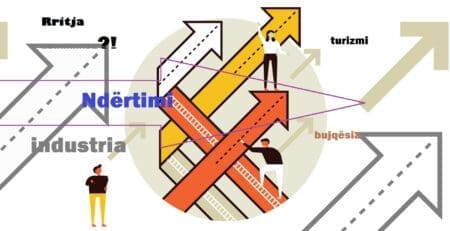Loans for businesses and individuals in an unusual dynamic
During the first 4 months of 2024, the second level banks have given an average of 940 million ALL in loans every day. The amount shows that the demand from businesses and citizens has increased this year.
New loans for businesses for the first quarter of 2024 is 58.1 billion ALL, with an increase of 52% compared to the first quarter of 2023.
While the new loan for individuals is ALL 24.6 billion, with an increase of 13.8% compared to the first quarter of last year.
Data from the Bank of Albania show that the loan in Lek accounts for the largest part of the amount. It reached 62% of the total, from 41% a year ago.
According to the Bank of Albania, the number of loans disbursed for businesses last year was about 42 thousand. The total amount of revenues was about 152 billion ALL, or about 2/3 of the entire disbursed loan. Loans for businesses make up about 38% of the number of disbursed loans.
While the number of loans granted to individuals was over 68,000, with a total amount of 77 billion ALL, or 1/3 of the value of disbursed loans. Loans for individuals make up about 62% of the total number of loans.
Loan expansion has been faster in the businesses segment, supported by a high demand for all categories of businesses. This rapid expansion, mainly in Lek, has served to finance the liquidity and investment needs of businesses. The loan for working capital recorded an average annual growth rate of 6%, while that for investments increased by about 13.5%, compared year to year.
For families and individuals, in the first quarter of 2024, an improvement in consumer credit was observed, which was mainly disbursed in Lek. Mortgage lending recorded an annual growth of 15% on average, similar to last year’s average growth, despite banks signaling tightening standards in this segment.
The data above show a significant increase in the number of businesses and consumers who applied for loans, compared to previous years.
This may seem surprising as borrowers currently have to pay higher interest rates and banks are lending more than in previous years.
What are the main drivers of this dynamic?
What the Albanian market suggests to us is closely related to the trend of financing the purchase of real estate, which is being targeted by all categories to be activated as working capital for the accommodation of the growing number of visitors in Albania in the last two years. .
Similarly, in the private sector, new loans have been disbursed for new investments mainly in the service sector, but also for working capital or for daily payments.
This increase in mortgage loans shows that there have been significant changes in the composition of groups of customers who apply for loans. Customers with higher incomes now apply for new loans less often, while households with lower incomes apply for them more often. On the other hand, banks now reject a smaller portion of applications, both for business and for individuals.
This change in the composition of loan requests may have caused banks to perceive the credit risk as lower than before. Indeed, the current cycle of tightening to a more relaxed extent than in 20923 is being conveyed to different groups of households regarding their participation in the credit market.
This relaxed lending policy has also been accompanied by a continuation of the injection of money into the market by the Bank of Albania, which has continued to carry out regular liquidity injection operations in the market, by means of its main instrument: one-week repo[1]. The amount injected during the first quarter was smaller than that of the previous quarter, in line with the needs of the market, but the level of liquidity was suitable for conveying the signals of the monetary policy in the money market.
A trend of the banking market, moreover, seems to have adapted to the reduced levels of the budget deficit and the tendency to restore the debt ratios on a downward path.
At the same time, a decline in the propensity to save (driven by relatively low interest rates on deposits) could boost consumption growth, while investment in housing construction could grow even faster. The risks associated with exchange rate changes, however, remain a major influencing factor on household, business and government balance sheet gains and losses.
It seems that this whole situation is unusual for the Albanian monetary market, since the problems of last year and before are still unresolved and are even more resistant in case extraordinary measures are taken by the Bank of Albania or the government from future unexpected blows.
What we advise for continuity is more related to the competitive risk of family businesses and medium-sized businesses, which may affect their competitive position. This risk is closely related to informal culture and speculation in the market, as well as further uncertainties related to the strengthening of the lek. If products continue to become more expensive for foreign buyers due to currency appreciation, businesses and the budgets that depend on them may lose growing market share.
Meanwhile, even though the geopolitical risk has not had a visible impact on the Albanian economy to date, in the circumstances in which the Albanian economy is being encouraged to run towards the tourism industry, it can lead to a great exposure that also has an impact on the sectors of related to this industry.
The increase in lending to businesses and individuals as a function of the service economy, mixed with the attraction of foreign capital, may further increase the value of the lek, but under the conditions that there may be risks of creating premises for financial “bubbles”.
However, a business or individual can control how to mitigate these risks. Any type of risk requires that business plans be made based on the financial balance and not on the expectations of the service market.
[1] Repurchase agreements are open market operations through which the Bank of Albania sells securities, undertaking to buy them under pre-agreed conditions with a second-tier bank, with the aim of temporarily reducing liquidity in the banking system




Leave a Reply
You must be logged in to post a comment.